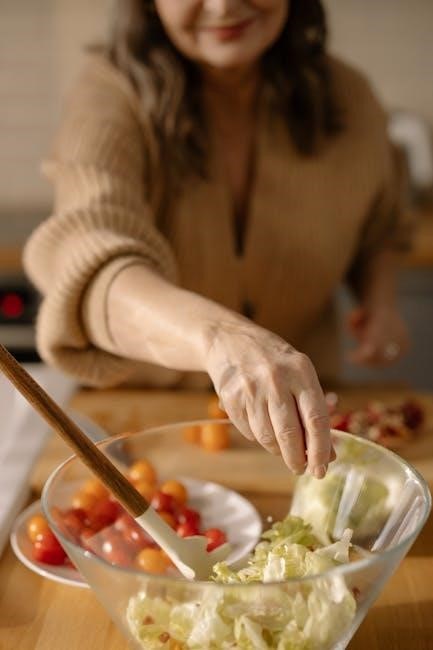This activity assesses your ability to prepare and cook a simple meal‚ focusing on tasks like peeling‚ chopping‚ and heating food safely‚ using fresh ingredients or ready meals.
1.1 Overview of Activity 1 in PIP Assessment
Activity 1 focuses on preparing and cooking food‚ assessing your ability to perform tasks like peeling‚ chopping‚ and heating food safely. It evaluates whether you can prepare a simple meal unaided‚ need aids‚ or require assistance. This section does not test culinary skills but measures how health conditions impact daily living tasks related to food preparation and cooking.
1.2 Importance of Preparing Food in Daily Living
Preparing food is a fundamental life skill‚ ensuring independence and proper nutrition. It involves essential tasks like peeling‚ chopping‚ and cooking‚ which are critical for maintaining health and well-being. Challenges in this area can significantly impact daily living‚ affecting quality of life and requiring external support‚ which is a key consideration in PIP assessments.
Key Descriptors for Preparing and Cooking Food
Descriptors assess ability to prepare and cook‚ ranging from unaided meal preparation to needing aids‚ appliances‚ or assistance‚ reflecting varying levels of independence in food tasks.
2.1 Can Prepare and Cook a Simple Meal Unaided
This descriptor applies if you can independently perform tasks like peeling‚ chopping‚ boiling‚ and frying without assistance. For example‚ peeling potatoes‚ opening a tin of sweetcorn‚ and frying meat or fish demonstrates the ability to prepare and cook unaided‚ showcasing independence in daily living skills.
2.2 Needs to Use an Aid or Appliance
This descriptor applies if you require tools like adaptive utensils or appliances to prepare or cook a meal. For example‚ using a food processor for chopping or relying on a microwave for cooking due to physical or sensory limitations demonstrates the need for aids to perform tasks safely and effectively.
2.3 Cannot Cook Using a Conventional Cooker but Can Use a Microwave
This descriptor applies if you cannot use a standard oven or hob but can prepare meals using a microwave. This may be due to physical limitations‚ sensory sensitivities‚ or cognitive challenges. Microwave cooking allows for simpler‚ safer meal preparation‚ such as heating ready meals or steaming vegetables‚ without the complexities of traditional cooking methods.
2.4 Needs Prompting to Prepare or Cook a Simple Meal
This descriptor applies if you require verbal reminders or physical guidance to start or continue preparing and cooking a simple meal. Conditions like cognitive impairments‚ memory issues‚ or anxiety may cause difficulties. Prompting ensures tasks like turning on appliances‚ monitoring cooking‚ or following steps are completed safely and effectively‚ enabling independence in meal preparation with necessary support.

PIP Form Questions 3a and 3b: Preparing and Cooking Food
These questions assess how your health condition impacts your ability to prepare and cook food‚ focusing on challenges and the support or assistance you require daily.
3.1 How Your Condition Affects Your Ability to Prepare Food
This section requires detailing how your health condition impacts your ability to prepare food‚ such as difficulties with chopping‚ cooking‚ or using appliances due to physical or sensory challenges. For example‚ if arthritis limits dexterity or anxiety prevents safe cooking‚ explain these barriers clearly. Be specific about how often and how severely these challenges occur‚ ensuring a clear link to your condition.
3.2 Support and Assistance Required for Cooking
Describe the type of support needed‚ such as using aids‚ appliances‚ or assistance from others. For example‚ if you require help with tasks like chopping or using a microwave‚ explain how often and why. Mention if someone needs to prompt you or perform dangerous tasks‚ like handling sharp objects‚ to ensure safety and effective meal preparation.

Example Answers for PIP Preparing Food Questions
Example answers illustrate struggles like difficulty chopping due to arthritis or needing a microwave for safety‚ helping claimants convey their challenges clearly and effectively.
4.1 Example 1: Difficulty Preparing Meals Due to Physical Limitations
Due to severe hand dexterity issues from rheumatoid arthritis‚ I require assistance with chopping vegetables and opening packaging. My mum prepares all meals‚ as I cannot safely use sharp objects or manage cookers without aid‚ relying on pre-chopped ingredients and microwavable options to ensure safety and accessibility.
4.2 Example 2: Challenges with Sensory Overload in Food Preparation
Due to sensory overload triggered by kitchen noises and bright lights‚ I struggle to prepare meals independently. The chaos of cooking environments often leads to anxiety or panic attacks‚ making it impossible to focus on tasks like chopping or boiling. I rely on pre-prepared ingredients and a caregiver to handle initial food preparation‚ ensuring meals are safe and manageable.

Common Challenges in Preparing and Cooking Food
Common challenges include visual and sensory difficulties‚ physical limitations‚ and environmental factors. These can hinder tasks like peeling‚ chopping‚ and using appliances‚ requiring assistance or adaptations for safety and efficiency.
5.1 Visual and Sensory Difficulties in Food Preparation
Visual impairments can hinder tasks like reading labels or judging cooking times. Sensory overload from noise or lights may cause anxiety‚ making food preparation challenging. Depth perception issues can lead to accidents‚ such as misjudging distances when placing items. These difficulties often require adaptive aids or assistance to ensure safety and independence in cooking tasks effectively.
5.2 Physical Limitations and the Need for Assistance
Physical limitations‚ such as arthritis or limited dexterity‚ can make tasks like chopping or opening packaging difficult. Some individuals may require aids‚ like adaptive utensils‚ to perform these tasks. In severe cases‚ assistance from others may be necessary for meal preparation due to challenges in standing‚ reaching‚ or safely using appliances. This impacts their ability to cook independently and consistently.
The Role of Aids and Appliances in Food Preparation
Aids like adaptive utensils and appliances such as microwaves can significantly assist individuals with physical or sensory limitations in preparing and cooking meals safely and effectively.
6.1 Examples of Aids Used for Preparing Food
Common aids include adaptive utensils like angled knives‚ vegetable choppers‚ and jar openers. Non-slip mats and ergonomic handles reduce strain‚ while perching stools allow rest during tasks. These tools enable individuals with physical or sensory challenges to prepare meals more safely and effectively‚ maintaining independence in daily living activities related to food preparation.
6.2 Appliances That Simplify Cooking Tasks
Microwaves are ideal for heating meals quickly and safely‚ while slow cookers allow preparation with minimal supervision. Food processors simplify chopping and mixing‚ reducing physical strain. Electric kettles provide instant hot water for beverages or instant meals. These appliances enhance independence‚ enabling individuals to prepare meals with ease‚ even when physical or sensory challenges are present.
Assessing Cooking Ability for PIP
Assessing cooking ability for PIP involves evaluating your capacity to prepare a simple meal safely and effectively‚ considering tasks like peeling‚ chopping‚ and using appliances‚ while ensuring you can perform these actions consistently and without undue difficulty.
7.1 Cooking a Simple Meal Safely and Effectively
Cooking a simple meal safely and effectively involves tasks like peeling‚ chopping‚ and using appliances. Assessors evaluate your ability to perform these actions without assistance‚ considering physical or sensory challenges. Safety is paramount‚ ensuring you can manage heat‚ sharp objects‚ and meal preparation without risking harm. Effectiveness also means completing the task within a reasonable time frame‚ demonstrating consistent ability to prepare a nutritious meal independently or with minimal aid. This assessment directly impacts PIP scoring‚ as it measures your independence in daily living activities.
7.2 Using a Microwave for Food Preparation
Microwave use simplifies cooking tasks‚ especially for those with physical or sensory limitations. It allows heating pre-prepared meals or cooking simple foods without complex steps. Assessors consider if you can safely operate a microwave‚ understand timing‚ and handle hot containers. This method is often viewed as an alternative to conventional cooking‚ demonstrating your ability to adapt and prepare meals independently‚ which impacts PIP scoring for daily living activities.

How Daily Struggles Impact PIP Scoring
Daily struggles‚ such as frequency and severity of challenges‚ directly impact PIP scoring by assessing your ability to perform tasks consistently and safely‚ influencing overall points awarded.
8.1 Frequency and Severity of Challenges
The frequency and severity of challenges in preparing food are critical in PIP scoring. Regular difficulties‚ such as daily struggles with meal prep due to physical or sensory limitations‚ are assessed. Severity is measured by how significantly these challenges impact your ability to perform tasks consistently and safely‚ affecting your overall PIP points allocation.
8.2 Impact on Ability to Perform Tasks Consistently
The impact on consistent task performance is crucial for PIP scoring. If challenges like physical limitations or sensory overload frequently prevent you from preparing meals‚ it highlights significant barriers. Consistency issues‚ such as needing regular assistance or being unable to complete tasks safely‚ demonstrate the severity of your condition’s impact on daily living and cooking abilities.
Tips for Completing the PIP Form
Be specific about your abilities and limitations when preparing food. Provide evidence of how your condition affects cooking tasks and include examples to support your claims clearly.
9.1 Being Specific About Your Abilities and Limitations
When filling out the PIP form‚ clearly describe your ability to prepare food‚ including specific tasks you can or cannot perform. Mention any aids‚ appliances‚ or assistance required. Provide examples‚ like difficulty chopping vegetables or safely using a cooker. Explain how often challenges occur and their impact on daily meals to ensure your limitations are fully understood by assessors.
9.2 Providing Evidence of Your Condition’s Impact
Include detailed examples of how your condition affects meal preparation‚ such as pain when chopping or difficulty using appliances. Attach supporting documents like medical letters or care plans. Describe specific incidents‚ like burns from a cooker due to sensory issues‚ to illustrate your needs. This evidence strengthens your claim and demonstrates the practical challenges you face daily.
Accurately detailing your ability to prepare food‚ supported by evidence‚ is crucial for a fair PIP assessment. Be honest and specific about your challenges to ensure your needs are fully considered.
10.1 Summary of Key Points for Preparing Food in PIP
Preparing food in PIP assesses your ability to make a simple meal‚ focusing on tasks like peeling‚ chopping‚ and heating. Key descriptors include unaided preparation‚ aid usage‚ microwave reliance‚ and prompting needs. Evidence and examples‚ such as difficulty chopping or safely using appliances‚ are crucial for accurate scoring. Consistency and safety in performing these tasks are central to your evaluation.
10.2 Final Tips for Maximizing Your PIP Score
Be specific about your abilities and limitations when preparing food. Provide detailed examples of challenges‚ such as difficulty chopping or safely using appliances. Highlight how your condition impacts consistency‚ safety‚ and independence in daily tasks. Emphasize any need for aids‚ prompting‚ or assistance. Clearly explain how these challenges affect your ability to prepare meals and live independently.
